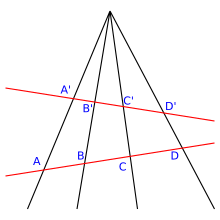Module room
In mathematics , a geometric space whose points correspond to the various mathematical objects of a certain type is called the module space of these objects.
For example, the projective plane is the module space of all straight lines through the zero point in . The module space of the elliptical curves above is the module curve
In algebraic geometry one has the definitions of a fine module space and a coarse module space for the classification of algebraic-geometric objects . The fine module space has better properties, but does not always exist.
In addition, in other areas of mathematics one speaks of module spaces of mathematical objects without there being a uniform definition for this term. For example, the module space of the pseudo-alcoholomorphic curves is of great importance in symplectic geometry or the module space of hyperbolic metrics in Teichmüller's theory .
example
The projective plane is by definition the set of 1-dimensional subspaces of the vector space . It can be provided with a differentiable atlas , so that families of 1-dimensional subspaces parameterized by a differentiable manifold correspond to the differentiable mappings , and the points each assign the straight line corresponding to the parameter in , i.e. a point .
Similarly, projective spaces can be interpreted as module spaces of 1-dimensional subspaces of one and general Graßmann manifolds as module spaces of k-dimensional subspaces of one .
Module Spaces in Algebraic Geometry: Definitions
Fine modular space
Let be a functor from the category of schemes into the category of sets, which assigns to each scheme the set of families of certain geometrical objects with a basis . Then the fine module space for the functor is if there is an isomorphism
gives.
The universal family is the family above that corresponds to the identity mapping .
Coarse module space
Let be a functor from the category of schemes into the category of sets, which assigns to each scheme the set of families of certain geometrical objects with a basis . Then there is a coarse modular space for the functor , if there is a natural transformation
that is universal with respect to all natural transformations.
There is generally no universal family for a coarse modular space.
Examples
- The fine module space of the equivalence classes of finite sets modulo bijection is the set of natural numbers .
- The fine module space of 1-dimensional sub-spaces is the projective level.
- Except for isomorphism there is only one 1-dimensional vector space and the point is actually a coarse module space of 1-dimensional vector spaces. But it is not a fine modular space, because the Möbius strip as a 1-dimensional vector bundle over the circle does not correspond to any illustration . But the point is a fine module space for the equivalence classes from a 1-dimensional vector space and one of different elements , because the Möbius strip as a 1-dimensional vector bundle has no intersection without zeros .
4-tuples of points on the projective line
The fine modular space for the quadruple pairs of different points on the projective line is obvious .
The universal family is a subset of , namely the union of the images of through for given sections .
Two quadruples are called projective equivalent if there is a projective automorphism that maps one quadruple onto the other. As is well known, the double ratio of a quadruple of two different points is an element of and two such quadruples are projectively equivalent if and only if they have the same double ratio. From this one can easily deduce that the fine modular space for quadruples is modulo projective equivalence and the universal family.
Module rooms in other areas of mathematics
- Modular space of the Riemannian metrics on a differentiable manifold
- Module space of the pseudoholomorphic curves in a symplectic manifold
- Module space of the flat connections of a principal bundle
literature
- David Mumford, John Fogarty, Frances Kirwan: Geometric invariant theory (= results of mathematics and their border areas . Volume 34 ). 3. Edition. Springer, Berlin 1994, ISBN 3-540-56963-4 (English).
- Alexander Grothendieck: Techniques de construction en géométrie analytique. I. Description axiomatique de l'espace de Teichmüller et de ses variantes . In: Séminaire Henri Cartan . tape 13 , no. 1 (1960-1961) . Secrétariat Mathématique, Paris, Exposés No. 7 and 8 (French).
- Carlos T. Simpson: moduli of representations of the fundamental group of a smooth projective variety I . In: Publications Mathématiques de l'IHÉS . tape 79 , 1994, pp. 47–129 (English, numdam.org ).
- Carlos T. Simpson: Moduli of representations of the fundamental group of a smooth projective variety II . In: Publications Mathématiques de l'IHÉS . tape 80 , 1994, pp. 5–79 (English, numdam.org ).
Web links
- Ben-Zvi: Moduli spaces (Princeton Companion to Mathematics)
- moduli space (nLab)
- Moduli Space (MathWorld)
- Clader: Mini-Course on Moduli Spaces
Individual evidence
- ↑ Wilderich Tuschmann, David J. Wraith: Moduli spaces of Riemannian metrics (= Oberwolfach Seminars . Volume 46 ). 2nd corrected edition. Birkhäuser, Basel 2015, ISBN 978-3-0348-0947-4 (English).
- ↑ Dusa McDuff, Dietmar Salamon: J-holomorphic curves and symplectic topology (= American Mathematical Society [Hrsg.]: Colloquium Publications . Volume 52 ). 2nd Edition. American Mathematical Society, Providence (RI) 2012, ISBN 978-0-8218-8746-2 (English).
- ^ Michael Francis Atiyah, Raoul Bott: The Yang-Mills equations over Riemann surfaces . In: Philosophical Transactions of the Royal Society A . tape 308 , no. 1505 . London 1983, p. 523-615 , doi : 10.1098 / rsta.1983.0017 (English).































